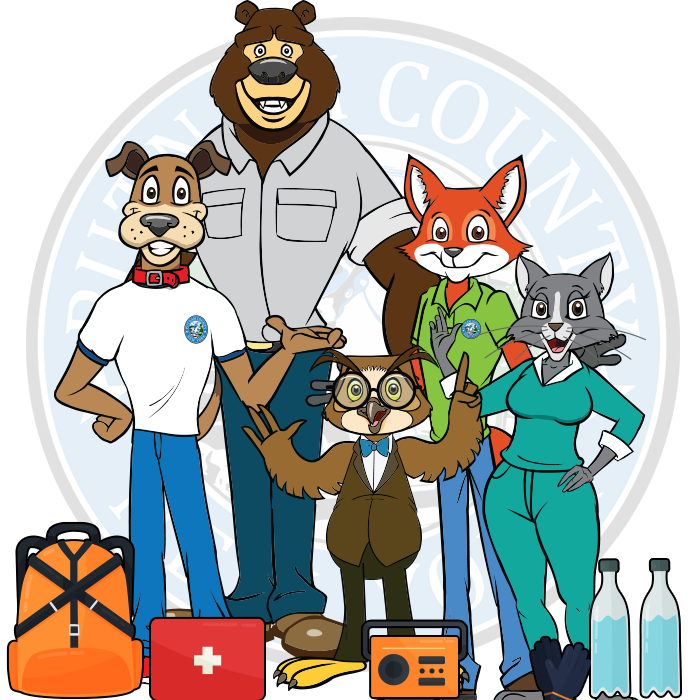- County Executive
- Elected Officials
- Legislature
- Departments
-
Welcome to the Putnam County Government Department Directory
Visit The Department Pages for Contact Information.
Note: The PUTNAM COUNTY COURTS are not affiliated with Putnam County Government. You can call the Putnam County Court’s phone system at 845.208.7800.
Hours of Operation
-
Regular Hours9:00am - 5:00pm
-
Summer Hours8:00am - 4:00pm
-
Our Partners
-
-
- Notices & Laws
- Tourism
- Careers
See Something? Say Something! Report Suspicious Activities Here! - PCTAM.NET
Quick Translate
PREADY
"PREADY"?
What's PREADY?


Hi! I'm PREADY!
PREPARED & READY!
I am PREPARED because I take safety courses, I talk to my family, and we practice safety drills. I am READYbecause I have food and supplies stocked, My GoBag is packed up, and I am signed up for Weather Alerts, which makes me
PREPARED & READY!

These are my friends! We are all PREPARED & READY!
Are you PREADY ?
Check and make sure that you and you family are PREADY! This interactive checklist will get you prepared and ready as you build your own PREADY, SET, GO! Emergency bag.

PLEASE NOTE:
PUTNAM COUNTY GOVERNMENT DOES NOT REVIEW OR RETAIN ANY OF YOUR INFORMATION. IF YOU'D LIKE US TO HELP PREPARE THIS, PLEASE COMPLETE THE CHECKLIST AND CONTACT THE BUREAU OF EMERGENCY SERVICES
FOR A ONE ON ONE CONSULTATION.

Let's Learn about
ALERTS & WARNINGS
A quick guide to learn about Alerts & Warnings,
their meaning and how to prepare for them.
ADVISORY & STATEMENT
Be aware! A hazard is expected to occur in your area or nearby, but its impact is not expected to be life threatening.
WATCH
Be prepared! A hazard may possibly occur in your area or nearby.
WARNING
Take action! A hazard is expected to occur or is already occurring in your area or nearby, and its impact may be serious.
“THIS IS A TEST”
Officials sometimes send test or practice messages. Consider using this as a reminder to check your emergency plan and supplies. Review the 12 Ways to Prepare for more steps to take
Some hazards may not have an advisory, watch, or warning. Use the 12 Ways to Prepare and be Ready for hazards that may happen suddenly. Visit ready.gov/be-informed to learn more about hazards not included in this guide. This is general guidance. Always defer to the alert.
12 Ways to Prepare
before disaster happens
Equip yourself with 12 ways to prepare before a disaster happens. Utilize a quick guide to learn about Alerts & Warnings, their meaning and how to prepare for them. Also, learn about how to prepare for weather events that affect our area such as Ice, Snow, Heavy Rain & High Winds.
You can use various sources to stay informed about severe weather alerts, such as local news, NOAA Weather Radio, or smart phone apps. You can also check the Weather-Ready Nation website for tips and resources on how to be weather-ready.
You should have a family emergency plan that includes an emergency meeting place, contact information, and escape routes. You should also identify a safe room in your home, such as a basement, storm cellar, or an interior room with no windows, where you can shelter during a severe thunderstorm, tornado, or winter storm.
You should have some cash on hand in case of power outages or other disruptions that may affect your access to banks or ATMs. You should also have an emergency fund that can cover your basic expenses for at least three months, in case you lose your income or have to relocate due to a disaster.
You should conduct regular drills with your family to practice what to do in case of a severe weather emergency. For example, you can practice how to get to your safe room, how to communicate with each other, and how to use your emergency supplies. You can also review your emergency plan and update it as needed. Practicing your plan will help you and your family stay calm and confident during a real emergency.
You should practice how to contact each other and where to meet in case of an emergency. You should also test your emergency alert systems and devices, such as radios, phones, or apps.
You should keep a binder of important papers, such as identification, financial, medical, and legal documents, in a fireproof and waterproof box or safe in your home. You should also store copies of your documents in an external location, such as a safe deposit box, and make electronic copies on a flash drive or CD.
You should get to know your neighbors and find out who may need assistance during an emergency. You should also create a community network to share updates and resources, and check on each other after a disaster.
You should identify the potential risks and issues that weather emergencies pose for your community. You should also form a committee to lead the planning and response efforts, and involve local organizations and authorities. You should develop a plan for sheltering, evacuating, and communicating during a weather emergency.
You should know your community’s local evacuation plan and identify several routes to leave the area in case roads are blocked. You should also plan your transportation and identify a safe place to evacuate to.
You should have an emergency supply kit that contains items such as water, food, first-aid supplies, flashlight, batteries, radio, and medications. You should also keep vital records in a safe place and store your policy number and contact information nearby.
You can get involved in your community by participating in local events, volunteering your time, donating your resources, shopping locally, joining a class or group, supporting your local sports teams, or becoming politically active.
You should document your property and its contents by taking photos, videos, or written descriptions. You should also have an appraisal for valuable items and store your inventory in a secure location. You should also understand your options for coverage and ensure you have appropriate insurance for relevant hazards. You should review your policy annually and update it as needed.
Types of Warnings & Alerts Guide
Learn more about the types of emergencies, their defenitions, and how to best prepare
for them when they occur.
ICE
SNOW
HEAVY RAIN
HIGH WIND
An ice storm occurs when significant ice accumulation causes dangerous travel conditions and damage to trees and power lines resulting in power outages.
A winter storm brings snow, sleet, ice accumulation, wind, or a combination of these hazards.
Heavy Rain & Thunder Storms are dangerous storm that can cause flooding and may include lightning.
A high wind event typically occurs when there are sustained winds of 40 mph or higher for one hour or more, or when there are wind gusts of 58 mph or higher for any duration.
Take action! Dangerous ice accumulation is expected due to freezing rain. An ice storm will occur within 12 to 48 hours.
If You Get this Alert at Home:
- Check supplies, food, and water, and make a plan to use these supplies for at least 3 days.
- Limit your time outside and wear warm clothes.
- Prepare for power outages and have a plan in case you lose heat.
Please note:
There is no Ice Storm Watch. Pay attention to Winter Storm Watches, which may alert you to ice storm conditions.
If You Get this Alert in Your Car:
- Put an emergency kit in your car.
- Stay off the roads.
Be prepared! There is a possibility of a winter storm containing snow, sleet, ice, wind, or a combination of these hazards. A winter storm may occur within 24 to 72 hours.
If You Get this Alert at Home:
- Gather supplies, food, and water, and make a plan to use these supplies for at least 3 days.
- Limit your time outside and wear warm clothes.
- Prepare for power outages and have a plan in case you lose heat.
If You Get this Alert in Your Car:
- Put an emergency kit in your car.
- Stay off the roads.
Take action! A winter storm is occurring or is about to occur; expect snow, sleet, ice, wind, or a combination of these hazards. A winter storm will occur within 12 to 48 hours.
If You Get this Alert at Home:
- Check supplies, food, and water, and make a plan to use these supplies for at least 3 days.
- Limit your time outside and wear warm clothes.
- Prepare for power outages and have a plan in case you lose heat.
If You Get this Alert in Your Car:
- Put an emergency kit in your car.
- Stay off the roads.
Be prepared! There is a possibility of severe thunderstorms. A severe thunderstorm watch typically lasts 4 to 8 hours.
If You Get this Alert at Home:
- When thunder roars, go indoors. Find a place to shelter.
- Secure outside furniture and property.
- Unplug appliances.
- Prepare for a power outage.
If You Get this Alert in Your Car:
- Stay in your car if you cannot go indoors.
- Do not drive through flood waters.
- Avoid touching metal surfaces in the car.
Take action! Severe weather is happening. There may be considerable or destructive damage.
A severe thunderstorm warning typically lasts 1 hour.
If You Get this Alert at Home:
- When thunder roars, go indoors. Find a place to shelter.
- Avoid using running water or landline phones.
- Unplug appliances.
- Avoid isolated trees, concrete, and metal that lightning could hit.
If You Get this Alert in Your Car:
- Stay in your car.
- Do not drive through flood waters.
- Avoid touching metal surfaces in the car.
Be prepared! Sustained, strong winds are possible.
A high wind event may occur within the next 12 to 48 hours.
If You Get this Alert at Home:
- Review your emergency plan.
- Be prepared to go to your safe shelter or small, interior, windowless room on the building’s lowest level.
- Protect your property. Put away or tie down loose outdoor furniture and objects.
- Prepare for power outages.
If You Get this Alert in Your Car:
- Delay or adjust travel plans.
Take action! Sustained, strong winds are occurring or about to occur. A high wind event may be occurring or about to occur and may last up to 12 hours or more.
If You Get this Alert at Home:
- Go to a safe, sturdy location and stay away from windows.
- Stay away from trees and power lines.
Take cover. Use your arms to protect your head and neck. - Prepare for power outages.
If You Get this Alert in Your Car:
- Stay off the roads.
- Slow down and watch for flying debris, downed power lines, and branches.
- Be cautious if driving in or near high-profile vehicles, which may be pushed by wind.
Learn more about additional types of emergencies,
their definitions, and how to best prepare
for them when they occur.
A blizzard is a winter storm during which snow is blown by sustained winds of 35 mph, greatly reducing visibility. A blizzard will reduce visibility to less than one-fourth mile for three hours or more.
Take action! A blizzard is expected or occurring.
A blizzard will occur within 12 to 48 hours.
If You Get this Alert at Home:
- Check supplies, food, and water, and make a plan to use these supplies for at least 3 days.
- Limit your time outside and wear warm clothes.
- Prepare for power outages and have a plan in case you lose heat.
There is no Blizzard Watch. Pay attention to Winter Storm Watches, which may alert you to blizzard conditions.
If You Get this Alert in Your Car:
- Put an emergency kit in your car.
- Stay off the roads.
Extreme or excessive heat (sometimes called a “heat wave”) is a period of abnormally hot weather that lasts more than two days. Heat waves can occur with or without high humidity.
Be prepared! Dangerous high temperatures
and/or humidities are possible. Extreme heat may occur within the next 24 to 72 hours.
If You Get this Alert at Home:
- Check on family members and friends to make sure they have a plan to stay cool.
- Learn the signs of heat-related illness.
- Prepare your home to keep heat out.
- Wear light, loose clothing.
- Avoid high-energy outdoor activities & Drink fluids.
If You Get this Alert in Your Car:
- Look before you lock. Do not leave people or
pets in closed cars
Take action! Dangerous high temperatures
and/or humidities are occurring or about
to occur. Extreme heat is occurring or will
occur within the next 12 hours.
- If You Get this Alert at Home:
- Cool down. Use air conditioning.
- Find shade if outside.
- Watch for signs of heat-related illness.
- Wear light, loose clothing.
- Avoid high-energy outdoor activities & Drink fluids.
If You Get this Alert in Your Car:
- Look before you lock. Do not leave people or
pets in closed cars
Extreme wind is wind greater than 115 mph and may signal that hurricane winds may begin shortly.
Take action! Dangerously strong winds are occurring and sustained hurricane winds may occur. Extreme wind is occurring or will occur within 1 hour.
If You Get this Alert at Home:
- Follow your emergency plan.
- Go to your safe shelter or small, interior, windowless room.
- Stay in the safe shelter and do not go into the calm of the hurricane eye.
- Take cover now. Use your arms to protect your
head and neck. - Extreme wind is wind greater than 115 mph and may signal that hurricane winds may begin shortly.
Please note:
There is no Extreme Wind Watch.
If You Get this Alert in Your Car:
- Slow down! Pull aside; stay alive! Move to the road’s shoulder, turn on the car’s hazard lights, and stay in the car.
- Be cautious if driving in or near high-profile vehicles, which may be pushed by wind.
A flash flood is a damaging and life-threatening, rapid rise of water into an area that’s normally dry. A flash flood may occur within minutes to hours after an event like intense rainfall or dam failure.
Take action! A dangerous, life-threatening flood is occurring or about to occur. A flash flood is occurring or about to occur.
If You Get this Alert at Home:
- Move to higher ground immediately if in a flood-prone area.
- Evacuate immediately if told to do so.
- Protect property only if it is safe to do so.
If You Get this Alert in Your Car:
- Turn Around Don’t Drown® Do not drive through flood waters.
- Avoid flood waters.
- Stay off bridges over fast-moving water.
Be prepared! There is a possibility of a flash flood.
A flash flood may occur within the next several hours or days.
If You Get this Alert at Home:
- Know your risk. Move to higher ground if in a flood-prone area.
- Evacuate immediately if told to do so.
- Protect your property if you have time and are staying in place.
- Put important documents in a waterproof container.
If You Get this Alert in Your Car:
- Turn Around Don’t Drown® Do not drive through flood waters.
- Avoid flood waters.
- Stay off bridges over fast-moving water.
Flooding is a temporary overflow of water onto land that is normally dry. Flooding may last days or weeks.
Be prepared! There is a possibility of flooding.
Flooding may occur within the next 6 to 48 hours.
If You Get this Alert at Home:
- Know your risk. Move to higher ground if in a flood-prone area.
- Evacuate immediately if told to do so.
- Protect your property if you have time and are staying in place.
- Put important documents in a waterproof container.
If You Get this Alert in Your Car:
- Do not drive through flood waters.
- Avoid flood waters.
- Stay off bridges over fast-moving water.
Take action! Flooding is occurring or about to occur.
Flooding is occurring or about to occur.
If You Get this Alert at Home:
- Know your risk.
- Move to higher ground if in a flood-prone area.
- Evacuate immediately if told to do so.
- Protect your property if you have time and are staying in place.
If You Get this Alert in Your Car:
- Do not drive through flood waters.
- Avoid flood waters.
- Stay off bridges over fast-moving water.
A high wind event typically occurs when there are sustained winds of 40 mph or higher for one hour or more, or when there are wind gusts of 58 mph or higher for any duration.
Be prepared! Sustained, strong winds are possible.
A high wind event may occur within the next 12 to 48 hours.
If You Get this Alert at Home:
- Review your emergency plan.
- Be prepared to go to your safe shelter or small, interior, windowless room on the building’s lowest level.
- Protect your property. Put away or tie down loose outdoor furniture and objects.
- Prepare for power outages.
If You Get this Alert in Your Car:
- Delay or adjust travel plans.
Take action! Sustained, strong winds are occurring or about to occur. A high wind event may be occurring or about to occur and may last up to 12 hours or more.
If You Get this Alert at Home:
- Go to a safe, sturdy location and stay away from windows.
- Stay away from trees and power lines.
Take cover. Use your arms to protect your head and neck. - Prepare for power outages.
If You Get this Alert in Your Car:
- Stay off the roads.
- Slow down and watch for flying debris, downed power lines, and branches.
- Be cautious if driving in or near high-profile vehicles, which may be pushed by wind.
A hurricane (called a “typhoon” in the Western Pacific) is
a storm system that forms over warm ocean waters and
can cause strong winds, heavy rains, and both coastal and inland flooding.
There is a possibility of hurricane conditions within the next several days. Hurricane-force winds are possible in the next 48 hours.
If You Get this Alert at Home:
- Know your area’s risk and whether you live in an evacuation zone.
- Follow your emergency plan.
- Check supplies, food, and water, and make a
plan to use these supplies for at least 3 days. - Protect your property and gather important
documents.
If You Get this Alert in Your Car:
- Do not drive through flood waters.
- Do not drive around barricades.
- Stay off bridges over fast-moving water.
Take action! Hurricane conditions are expected within the next several days. Hurricane-force winds are
expected in the next 36 hours.
If You Get this Alert at Home:
- Evacuate immediately if told to do so.
- Follow instructions from local officials.
- Follow your emergency plan.
If You Get this Alert in Your Car:
- Do not drive through flood waters.
- Do not drive around barricades.
- Stay off bridges over fast-moving water.
An ice storm occurs when significant ice accumulation causes dangerous travel conditions and damage to trees and power lines resulting in power outages.
Take action! Dangerous ice accumulation is expected due to freezing rain. An ice storm will occur within 12 to 48 hours.
If You Get this Alert at Home:
- Check supplies, food, and water, and make a plan to use these supplies for at least 3 days.
- Limit your time outside and wear warm clothes.
- Prepare for power outages and have a plan in case you lose heat.
Please note:
There is no Ice Storm Watch. Pay attention to Winter Storm Watches, which may alert you to ice storm conditions.
If You Get this Alert in Your Car:
- Put an emergency kit in your car.
- Stay off the roads.
A nuclear explosion emits dangerous radiation and fallout. Fallout is most dangerous in the first few hours after the detonation. After an explosion, it will take 10 to 15 minutes before fallout begins to arrive
Take action! A nuclear explosion is occurring or is about to occur. A nuclear explosion may occur with
little to no warning.
If You Get this Alert at Home:
- Get inside and go to the basement or middle of the building. Stay away from windows.
- Stay inside for 24 hours unless local officials provide other instructions.
- Use your emergency supplies, food, and
water. - Do not consume foods or liquids that were outside and uncovered.
- Remove contaminated clothing and wipe off exposed skin.
If You Get this Alert in Your Car:
- Get inside. Vehicles will not provide adequate
protection. - Go to the basement or middle of the
building. Stay away from windows
Please note:
There is no Nuclear Explosion Watch.
A severe thunderstorm is a dangerous storm that includes lightning.
Be prepared! There is a possibility of severe thunderstorms. A severe thunderstorm watch typically lasts 4 to 8 hours.
If You Get this Alert at Home:
- When thunder roars, go indoors. Find a place to shelter.
- Secure outside furniture and property.
- Unplug appliances.
- Prepare for a power outage.
If You Get this Alert in Your Car:
- Stay in your car if you cannot go indoors.
- Do not drive through flood waters.
- Avoid touching metal surfaces in the car.
Take action! Severe weather is happening. There may be considerable or destructive damage.
A severe thunderstorm warning typically lasts 1 hour.
If You Get this Alert at Home:
- When thunder roars, go indoors. Find a place to shelter.
- Avoid using running water or landline phones.
- Unplug appliances.
- Avoid isolated trees, concrete, and metal that lightning could hit.
If You Get this Alert in Your Car:
- Stay in your car.
- Do not drive through flood waters.
- Avoid touching metal surfaces in the car.
A snow squall is a 30- to 60-minute storm that brings whiteout conditions. Snow and gusty winds may cause low visibility and icy roads, making driving dangerous.
Take action! A winter storm is occurring or is about to occur; expect snow, sleet, ice, wind, or a combination of these hazards. A winter storm will occur within 12 to 48 hours.
If You Get this Alert at Home:
- Check supplies, food, and water, and make a plan to use these supplies for at least 3 days.
- Limit your time outside and wear warm clothes.
- Prepare for power outages and have a plan in case you lose heat.
If You Get this Alert in Your Car:
- Put an emergency kit in your car.
- Stay off the roads.
A tornado is a violently rotating column of air that extends from a thunderstorm t o the ground. Most tornadoes last less than 10 minutes.
Be prepared! There is the potential that a tornado will develop. A tornado may occur within the next 2 to 4 hours.
If You Get this Alert at Home:
- Review your emergency plan.
- Check on family members and friends to make sure they have a plan.
- Be prepared to go to your safe shelter.
Take action! A tornado is occurring or about to occur in the area or nearby. A tornado may occur within the
next few minutes to half hour.
If You Get this Alert at Home:
- Go to your safe shelter immediately.
- Go to a sturdy building or small, interior, windowless room on the building’s lowest level.
- Stay away from windows, doors, and exterior walls.
- Take cover. Use your arms to protect your head and neck.
If You Get this Alert in Your Car:
- If you cannot go to a safe place, take cover.
- Use your arms, a coat, or blanket to cover your head and neck.
- Do not try to outrun a tornado.
- Do not hide under a bridge or overpass. Go to a low, flat location.
Storm surge is a life-threatening flood that comes from rising water that moves inland.
Be prepared! There is a possibility of life-threatening flooding. A storm surge may occur within 48 hours.
If You Get this Alert at Home:
- Know your risk.
- Follow instructions from local officials and evacuate immediately if told to do so.
If You Get this Alert in Your Car:
- Do not drive through flood waters.
- Do not drive around barricades.
- Stay off bridges over fast-moving water.
Take action! There is a danger of life-threatening flooding. A storm surge may occur within 36 hours.
If You Get this Alert at Home:
- Know your risk.
- Follow instructions from local officials and evacuate immediately if told to do so.
If You Get this Alert in Your Car:
- Do not drive through flood waters.
- Do not drive around barricades.
- Stay off bridges over fast-moving water.
A winter storm brings snow, sleet, ice accumulation, wind, or a combination of these hazards.
Be prepared! There is a possibility of a winter storm containing snow, sleet, ice, wind, or a combination of these hazards. A winter storm may occur within 24 to 72 hours.
If You Get this Alert at Home:
- Gather supplies, food, and water, and make a plan to use these supplies for at least 3 days.
- Limit your time outside and wear warm clothes.
- Prepare for power outages and have a plan in case you lose heat.
If You Get this Alert in Your Car:
- Put an emergency kit in your car.
- Stay off the roads.
Take action! A sudden whiteout is occurring or about to occur. A snow squall is occurring or may occur soon.
If You Get this Alert at Home:
- Check supplies, food, and water, and make a plan to use these supplies for at least 3 days.
- Limit your time outside and wear warm clothes.
- Prepare for power outages and have a plan in case you lose heat.
- There is no Snow Squall Watch.
If You Get this Alert in Your Car:
- Reduce your speed, turn on headlights and hazards, and keep space between you and the car in front of you.
- Stay off the roads, if possible.


Putnam County Office Building
40 Gleneida Avenue
Carmel, New York 10512
© 2005 - Putnam County Online
Powered by ![]() Flight
Flight